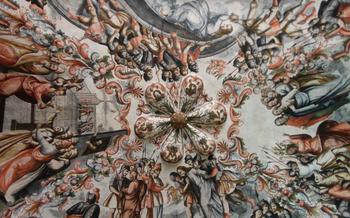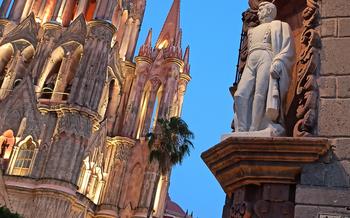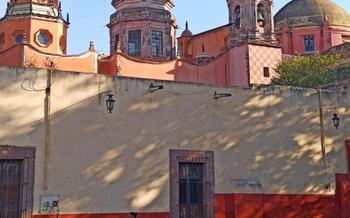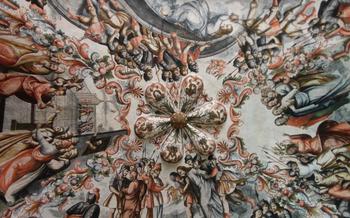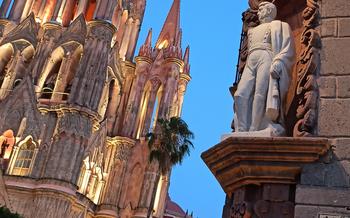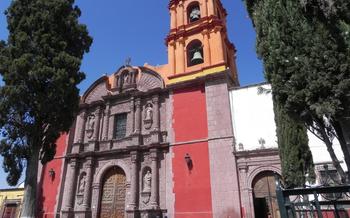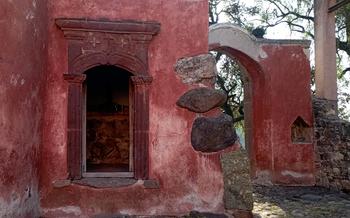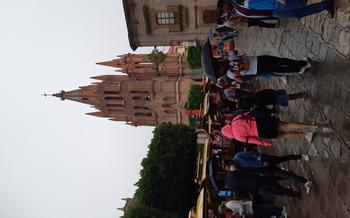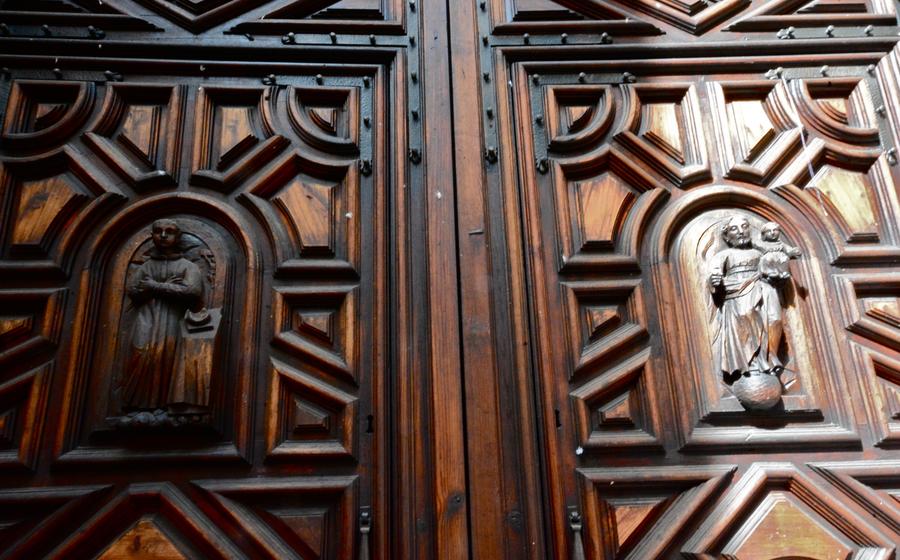
Templo de la Concepción (Las Monjas)
- A Colonial Masterpiece
- Nuns and the Convent
- An artistic treasure trove
- Exploring the Convent
- The Templo de la Concepción Museum
- The founding of San Miguel de Allende
- A UNESCO World Heritage Site
- The Templo de la Concepción's Musical Heritage
- The Monjas' Garden
- The Gift Shop
- Hours, Admission, and Accessibility
- Getting to the Templo de la Concepción
- Nearby attractions and activities
- Insider tip
A Colonial Masterpiece
The Templo de la Concepción, also known as Las Allende. Its history is deeply intertwined with the city's founding and the arrival of the Franciscan order in the 16th century. The construction of the convent began in 1550 and was completed in 1706, showcasing a blend of architectural styles that reflect the transition from late Gothic to Baroque and neoclassical influences. The Templo de la Concepción served as a religious and educational center for the nuns who resided within its walls, contributing to the spiritual and cultural development of San Miguel de Allende. Its enduring significance led to its designation as a UNESCO World Heritage Site in 2008, recognizing its exceptional universal value and the need to preserve this architectural masterpiece for generations to come.
Nuns and the Convent
The Templo de la Concepción was not just a physical structure; it was a vibrant community, inhabited by the cloistered nuns of the Franciscan order. These nuns played a pivotal role in the establishment and maintenance of the convent. They dedicated their lives to religious devotion, following strict daily routines and rituals. Their days were filled with prayer, meditation, and various chores to sustain the convent's daily needs.
The nuns were not only spiritual guides but also skilled artisans and educators. They were responsible for creating beautiful artwork, embroidering intricate textiles, and producing religious music. Their artistic talents contributed significantly to the convent's aesthetic appeal and reputation as a center of artistic production.
Beyond their religious duties, the nuns played a crucial role in the community. They provided education to young girls, offered medical assistance to the sick, and distributed charity to the needy. Their presence and dedication had a profound impact on the social fabric of San Miguel de Allende.
Despite the secularization of the convent in the 19th century, the legacy of the nuns remains deeply embedded in the city's cultural identity. Their contributions to education, healthcare, and the arts continue to shape the vibrant community that San Miguel de Allende is today.
An artistic treasure trove
The Templo de la Concepción is a testament to the artistic brilliance of the 18th century. Its Baroque and neoclassical architecture is a feast for the eyes, showcasing intricate carvings, ornate facades, and stunning murals. The convent's interior is adorned with significant murals and paintings, including works by Miguel Cabrera, a renowned Mexican artist. Exquisite sculptures and carvings grace the walls, columns, and altars, depicting biblical scenes and religious figures. The convent was a center of artistic production, with nuns and local artisans contributing to its rich artistic heritage. Visitors can admire the skillful craftsmanship and attention to detail that went into every piece of artwork, making the Templo de la Concepción a true artistic treasure trove.
Exploring the Convent
Step inside the Templo de la Concepción and immerse yourself in its captivating ambiance. Guided tours are available, offering insightful narratives about the convent's history and significance. Alternatively, embark on a self-guided exploration, allowing you to savor the tranquil atmosphere at your own pace.
Within the convent's walls, discover a treasure trove of architectural wonders. The cloister, with its serene courtyard and elegant arches, invites you to pause and reflect. The chapel, adorned with intricate altarpieces and radiant stained-glass windows, exudes a sense of devotion. The museum, housed within the convent's former living quarters, showcases artifacts, paintings, and sculptures that narrate the story of the nuns and their enduring legacy.
As you wander through the convent's hallowed halls, pay homage to the nuns who dedicated their lives to faith and service. Their presence lingers in the peaceful surroundings, creating an atmosphere of serenity and contemplation. Respect the sacred nature of this site as you explore, ensuring that your presence does not disturb the tranquil rhythm of the convent.
The Templo de la Concepción Museum
The Templo de la Concepción Museum was established site. The museum houses a collection of artifacts, exhibits, and displays that provide a glimpse into the daily lives of the nuns, the artistic production of the convent, and the role it played in the founding and development of San Miguel de Allende.
Visitors to the museum can explore various exhibits that showcase religious art, objects used by the nuns, and historical documents related to the convent's founding and operation. The museum also features a collection of paintings, sculptures, and carvings that demonstrate the artistic prowess of the nuns and the influence of various artistic styles, including Baroque and neoclassical.
Through its exhibits, the Templo de la Concepción Museum plays a vital role in preserving and sharing the legacy of the convent and its significance to the city and region. It offers visitors a deeper understanding of the spiritual, cultural, and artistic contributions of this historic institution.
The founding of San Miguel de Allende
The Templo de la Concepción played a The Templo de la Concepción was constructed in the early 17th century as a symbol of the Spanish colonial power and as a means to evangelize the indigenous population. The church became the spiritual center of the community, attracting settlers and contributing to the city's growth and development.
Over time, San Miguel el Grande evolved into a thriving mining town, drawing people from various backgrounds and cultures. The Templo de la Concepción served as a unifying force, bringing together diverse communities under a shared faith. The church also played a crucial role in the city's cultural development, becoming a hub for artistic expression and education. The establishment of the convent and the presence of the nuns further contributed to the city's reputation as a center of learning and spirituality.
Today, San Miguel de Allende stands as a testament to its rich history and cultural heritage. The Templo de la Concepción remains a symbol of the city's founding and its enduring faith. Visitors to San Miguel de Allende can explore the church and the convent, gaining insights into the city's origins and the crucial role that religion played in shaping its identity.
A UNESCO World Heritage Site
The Templo de la Concepción holds a revered position as a UNESCO World Heritage Site, a testament to its exceptional cultural and historical significance. To be inscribed on this prestigious list, a site must meet specific criteria, demonstrating outstanding universal value. The Templo de la Concepción fulfills these criteria with its remarkable architectural ensemble, exquisite artwork, and its profound influence on the development of San Miguel de Allende.
The convent's unique blend of Baroque and neoclassical styles, its intricate carvings and sculptures, and its awe-inspiring murals contribute to its outstanding universal value. Moreover, the Templo de la Concepción stands as a testament to the enduring power of faith and the dedication of the nuns who devoted their lives to preserving and nurturing the spiritual and cultural heritage of the region.
The designation as a UNESCO World Heritage Site not only recognizes the Templo de la Concepción's exceptional value but also places it under international protection. This recognition brings with it a responsibility to ensure the site's preservation and conservation for future generations to appreciate and enjoy. Ongoing efforts are underway to protect and maintain the convent's integrity, ensuring that its legacy will continue to inspire and captivate visitors for years to come.
The Templo de la Concepción's Musical Heritage
The Templo de la Concepción center of music and the arts, and many of the nuns were accomplished musicians and singers. They played an important role in the development of the city's musical culture, and their influence can still be felt today.
The convent's musical heritage is evident in the many concerts and musical performances that are held there throughout the year. The convent's acoustics are perfect for music, and the performances are always well-attended by both locals and tourists. The convent also has a music school, which offers classes to students of all ages.
The Templo de la Concepción's musical heritage is an important part of the convent's history and identity. It is a tradition that is still alive today, and it continues to play an important role in the cultural life of San Miguel de Allende.
Here are some tips for experiencing the Templo de la Concepción's musical heritage:
- Attend a concert or musical performance at the convent.
- Visit the convent's music school and learn about the history of music at the convent.
- Take a class at the convent's music school and learn to play a musical instrument.
- Listen to the music of the nuns on a recording.
The Monjas' Garden
Nestled within the serene confines of the Templo beauty. This enchanting garden, once the private retreat of the convent's nuns, has been lovingly restored and opened to the public, offering visitors a glimpse into the cloistered world of these devoted women.
As you step into the garden, an intoxicating fragrance greets you, emanating from the vibrant array of flowers that bloom throughout the year. Carefully manicured paths wind through the garden, leading visitors past meticulously arranged flower beds, fruit trees, and fragrant herbs. The nuns, with their deep connection to nature, cultivated this garden not only for its aesthetic beauty but also for its medicinal and culinary uses.
Amidst the lush greenery, you'll find hidden corners and intimate seating areas, inviting you to pause and reflect. The gentle murmur of water from a nearby fountain adds to the tranquil atmosphere, creating a sanctuary for contemplation and serenity.
Whether you seek a moment of respite from the bustling city or a deeper connection with the spiritual heritage of the convento, The Monjas' Garden is a must-visit for anyone seeking solace and inspiration in the heart of San Miguel de Allende.
The Gift Shop
The Templo de la Concepción's gift shop offers a range of unique and meaningful souvenirs to enhance your visit. Located within the convent, the gift shop is a treasure trove of religious and cultural items. Proceeds from the gift shop directly support the conservation and preservation of the convent, ensuring its legacy for generations to come.
From intricately designed rosaries and prayer beads to hand-painted ceramics and textiles, the gift shop showcases the artistry and craftsmanship of local artisans. You can find beautiful reproductions of the convent's artwork, including miniature versions of the Virgin of Immaculate Conception statue and prints of the convent's murals. These souvenirs not only serve as mementos of your visit but also contribute to the ongoing preservation of the convent's rich history and heritage.
When shopping at the gift shop, remember to be respectful of the sacred nature of the site. Avoid purchasing items that may be considered inappropriate or disrespectful. Instead, opt for souvenirs that celebrate the convent's cultural and artistic significance.
By supporting the gift shop, you become a part of the effort to preserve this remarkable landmark for future generations. Your purchase contributes to the maintenance, restoration, and educational programs that ensure the Templo de la Concepción continues to inspire and captivate visitors for years to come.
Hours, Admission, and Accessibility
The Templo de la Concepción welcomes visitors with open arms, offering a glimpse into its rich history and artistic wonders. To ensure a smooth and enjoyable experience, it is essential to be aware of the hours of operation and admission fees. The convent is typically open from 10:00 AM to 6:00 PM, Tuesday through Sunday, allowing ample time to explore its many treasures. While admission is free of charge, donations are gratefully accepted to support the ongoing preservation and maintenance of this sacred site.
For those with limited mobility or disabilities, the Templo de la Concepción is wheelchair accessible, ensuring that everyone can fully immerse themselves in its beauty. The cobblestone streets and uneven terrain surrounding the convent may require extra caution, but the staff is always ready to assist visitors in any way they can.
To avoid crowds and fully appreciate the serene atmosphere of the convent, consider planning your visit during the early morning hours or on weekdays when the number of visitors tends to be lower. Dressing appropriately for a religious site is essential, so opt for modest clothing that covers your shoulders and knees. This small gesture shows respect for the sacred nature of the Templo de la Concepción and its community.
Getting to the Templo de la Concepción
The Templo de la Concepción is conveniently and amenities. To get there, you can opt for a leisurely walk or utilize various transportation options.
If you prefer to stroll, the convent is just a short distance from the city's main square, the Jardín Principal. As you wander through the charming cobblestone streets, you'll be greeted by colorful colonial buildings, art galleries, and boutiques, making the journey itself an enjoyable experience.
For those who prefer a quicker mode of transport, taxis and ride-sharing services are readily available. Simply provide the driver with the address or the name of the convent, and they'll be happy to take you there.
Once you arrive, you'll find ample parking options nearby. There are several public parking lots within walking distance, as well as on-street parking spaces.
After parking your vehicle, take a moment to appreciate the surrounding historic center. The Templo de la Concepción is nestled amidst beautifully preserved colonial architecture, inviting you to explore the city's rich past and vibrant present.
Nearby attractions and activities
Your visit to the Templo de la Concepción can be easily combined with other cultural experiences and attractions in San Miguel de Allende. The city's historic center, a UNESCO World Heritage Site, is a treasure trove of colonial architecture, art galleries, and museums. Take a leisurely stroll through its cobblestone streets, admiring the colorful facades and lively plazas.
For a taste of local culture, visit the bustling Mercado de Artesanías, where you can browse and purchase traditional crafts, textiles, and souvenirs. Indulge in the city's renowned culinary scene by sampling delicious Mexican cuisine at one of the many restaurants or cafes.
San Miguel de Allende is also known for its vibrant arts scene. Attend a concert or performance at the Teatro Ángela Peralta, or visit the Instituto Allende, a renowned center for the arts that offers workshops and exhibitions.
To immerse yourself in nature, take a day trip to the nearby Cañada de la Virgen, a beautiful canyon with stunning views and hiking trails. Or explore the mystical Sanctuary of Atotonilco, a pilgrimage site with elaborate Baroque architecture and murals.
By combining your visit to the Templo de la Concepción with these diverse attractions, you'll gain a deeper understanding of San Miguel de Allende's rich history, culture, and vibrant contemporary life.
Insider tip
-
To fully appreciate the tranquil atmosphere of the Templo de la Concepción, plan your visit for a weekday morning when the crowds are fewer. This will allow you to immerse yourself in the serene surroundings and truly connect with the convent's spiritual essence.
-
As you explore the convent, keep an eye out for the intricate details often overlooked by visitors. Look for the delicate carvings adorning the doorways, the hidden niches housing religious artifacts, and the subtle symbolism embedded in the artwork. These details add layers of meaning and depth to the convent's story.
-
To capture the best photos of the Templo de la Concepción, visit during the golden hours of sunrise or sunset. The warm, diffused light beautifully illuminates the convent's facade, casting long shadows that enhance its architectural features. Remember to be respectful and mindful of the sacred nature of the site when taking photos.
-
When visiting the convent, observe local customs and traditions. Dress modestly, avoid loud noises, and be mindful of the nuns' presence. Remember that the Templo de la Concepción is an active place of worship, and it's essential to respect the religious practices and beliefs of the community.
